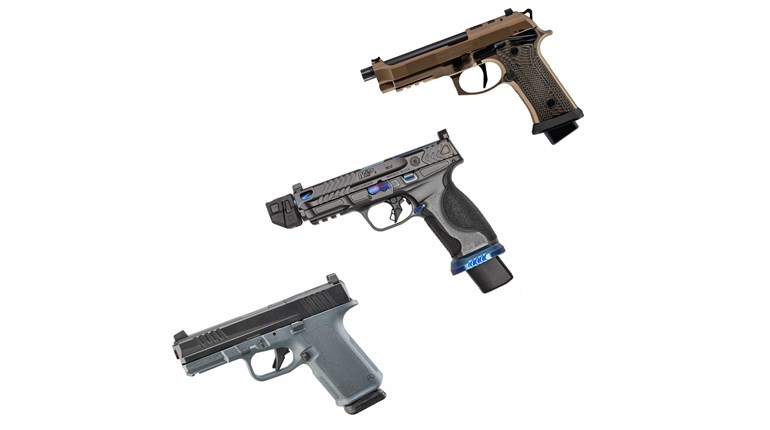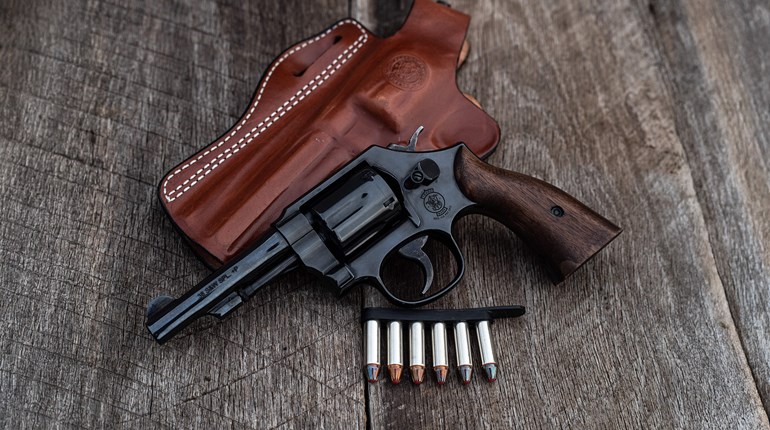
Firearms change as a function of need. When the pistoleros of yesteryear saw a need for more performance—or even just convenience—things changed. It has been that way for centuries. One of the more notable examples of this trend is the revolver. After a century-and-a-half of six shooters, someone noticed one or two more firing chambers can be fitted into that cylinder. We now have seven and even eight rounds in some powerful calibers. This piece will focus on a developing need that came on the handgun scene.
Colt firearms dominated the American revolver market with the Model P (SAA or Peacemaker) in the 1890s. In an effort to appeal to bullseye-target shooters, the venerable firm introduced an offshoot of the Model P called the Bisley. This new single-action changed its grip and hammer shape to handle better in rapid- and timed-fire courses. Offered in many chamberings and other variations, the Bisley lasted about 20 years and was a moderate success. The Bisley’s grip has an arch to the round-butt profile that places the shooter’s hand closer to the direction of the recoil thrust. More improvement comes from the Bisley hammer-spur twist, which is somewhat more compact than that of the SAA.
Because Bisleys are rarer than Peacemakers, they are less often found in use. In field use, some shooters have followed the example of the late Elmer Keith and his associates by building a so-called “Number 5” with a Bisley hammer and backstrap, plus SAA trigger guard. In a Colt in either .45 Colt or .44 Spl., this makes for a rugged field gun with—best of all—traditional origins. If you are a shooter who wants to actually shoot period sixguns, most of them are available via the Italian arms-replica industry. I have yet to see an all-replica custom project, but I have had a spectacular custom project that I wanted to share.
I wanted to create a Colt SAA revolver with a mixture of traditional and modern features. My dream gun would be strong, accurate and attractive. The first step was finding a base gun. In effect, I needed the basic Bisley butt section, and I found one in one of the listings in an online gun sale. Usually, an original Bisley would be too valuable to modify. This specimen was in excellent condition, but had been re-barreled and re-cylindered with unmarked parts and had been fitted with a wild pair of thumb-rest grips. The action parts were original and went into the finished gun.
Since I was planning on some serious work with this project as a shooter, I wanted large, visible sights. There were a number of options, but I settled on a rather bold stroke—another gun. I found another Colt; a target-sighted New Frontier that was a bit worn. The frame of this model has the flat-top used on several Colts. I heard that the turn-of-the-century parts on the original Bisley would interface with the 1970-vintage New Frontier. They did—even though there was over a century of gunmaking between the two single actions.
The last major problem we had to deal with was a barrel and cylinder. The cylinder was one from Colt parts (.44 Spl.) and the 8 3/8-inch barrel was from a Smith & Wesson Model 29. Here, Smith’s integral solid-top-rib barrel provides a handsome and sleek look to the finished barrel. It finished up almost exactly 7 inches. A lot of work—who did it?
I sent the project to Bobby Tyler at the Gunworks of the same name in Texas. His shop and staff are rapidly achieving a reputation among the best custom pistolsmiths in the country. Tyler has refined the procedure for casehardening, an old-time metalsmith’s skill. As much as I have indulged my tastes in custom handguns, I have never let anyone persuade me to have a gun engraved, but I tried it on this one.
If there is a crown jewel to the project, I would guess it would have to be the grips. I sent Tyler a chunk of a rare South American hardwood called Mirindiba. A dark brown with a black fiddleback, the wood had the figure all the way from one side to the other.
There’s much to appreciate here. It bears a famous name in firearms and throws those 240-grain Keith slugs. It is a Bisley, and the barrel is so marked: “Colt New Frontier Bisley .44.” The owner’s initials are on the broad topstrap. The butt is shaped as international competitors demanded and the gun tastefully engraved.
It was made for cutting holes in paper, but often saw to the protection of its owner as fightin’ iron.



































